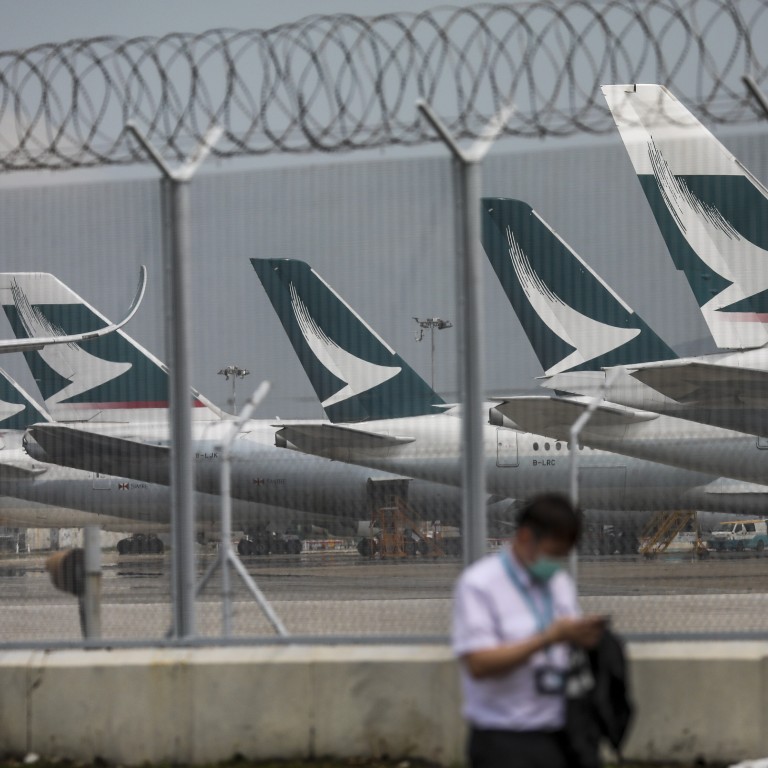
Hong Kong’s Cathay Pacific, Cathay Dragon will not tap next round of Covid-19 wage relief, opening door to lay-offs
- Accepting city’s coronavirus wage relief means agreeing to not let staff go, something the embattled airlines are not prepared to do as they eye future
- Subsidiaries, which include HK Express and Air Hong Kong, however, will take advantage of round three of the Covid-19 package, the company says
“After careful consideration, we have decided that Cathay Pacific and Cathay Dragon will not submit applications to the scheme,” said Andy Wong, the airline’s general manager of corporate affairs.
Cathay Pacific to park up to half its fleet in desert amid coronavirus struggles
Several subsidiaries, namely HK Express, Air Hong Kong, Cargo Terminal, Hong Kong Airport Service and Cathay Pacific Catering Services, would be applying to the scheme, according to the company.
“Different industries and businesses have been affected to varying extents by Covid-19, with aviation and hospitality being some of the most severely impacted,” Wong said. “The Cathay Pacific Group is no exception to this … which is why some subsidiaries will be applying to the scheme.”
Based on the airline’s timeline and the looming expiration of the wage subsidy, lay-offs could begin in October. Otherwise, any redundancies would be put off until at least December for those who apply for the scheme again.
“We continue to make decisions based on the long-term interests of the company and the Hong Kong aviation hub, to protect our future and as many people as possible. We will share more details on our plans when available,” Wong said.
Moving beyond Covid-19: Cathay Pacific wrestles with uncertainty, hard choices
In a memo explaining the airline’s decision, chief executive Augustus Tang Kin-wing told staff: “The resilience of our people has always been a Cathay Pacific trait, and I know that these uncertain times are challenging for all of us. I will be in a position to provide clarity to all of you once our plans have been finalised and I appreciate your patience during this period.”
The focus of coming job and cost cuts appears squarely aimed at the company’s two biggest business units, Cathay Pacific and Cathay Dragon, which employ 26,500 people. The wider group counts 33,000 staff, including those working for its catering and frequent flier businesses.
Key rival Singapore Airlines on Thursday said 4,700 jobs would be axed. Despite a hiring freeze, early retirements and natural attrition, the airline said it still needed to cut another 2,400 positions.
Airlines around the world are dealing with the biggest crisis in aviation history. Some have disappeared already, others are at risk and even more have frantically raised cash to compensate for a collapse in revenue and passenger demand for travel.

Redundancies have been a key part of ensuring survival. Qantas said last month that 8,500 jobs – 30 per cent of its pre-pandemic workforce – would be axed. A third of Virgin Australia’s 9,000 jobs are to go. British Airways said it had cut 8,236 jobs through voluntary redundancies, leaving almost 5,000 more roles to be culled.
Between the big American carriers, tens of thousands of jobs have been earmarked for furlough or elimination.
Companies taking part in Hong Kong’s Employment Support Scheme, launched to ease the economic blow from the pandemic and now in its second round, are not allowed to make redundancies as a condition of accepting the cash.
Cathay Pacific warns of harsh outlook as it confirms record HK$9.9 billion loss
Cathay Pacific in June unveiled a HK$39 billion (US$5.03 billion) recapitalisation scheme that included HK$27.3 billion from the government. It lost HK$9.87 billion in the first six months of 2020.
Under the HK$81 billion wage relief scheme first announced in March, the government is offering to pay 50 per cent of employees’ salaries for six months, capped at HK$9,000 per worker each month.
In the first round of the scheme covering June to August, the airline and its subsidiaries received HK$707 million.
The Airport Air Freight Employees’ Association – which mainly consists of frontline and ground attendants – expressed regret at the company’s decision to not join the wage subsidy scheme.
“We hope Cathay Pacific can discuss thoroughly with unions if there are any future actions so as to minimise the impacts on employees,” it said.
“And Cathay should also uphold its social responsibility to minimise the scale of lay-offs, and to think of some substitute plans, especially after it got the government’s cash injection in July.”
Cathay’s daily passenger traffic has collapsed by 99 per cent, and it has grounded most passenger flights, scrapping most of its schedules. The Post reported this week that the airline might send half its planes for long-term storage abroad as it braces for a difficult winter amid slow recovery.

